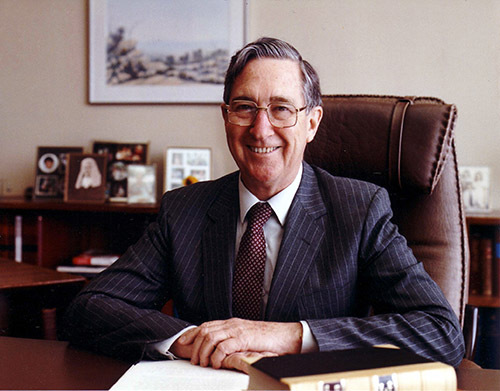- Winter 2022
- The Honourable Sir Francis Gerard Brennan AC KBE GBS (1928-2022). Tenth Chief Justice of the High Court of Australia
The Honourable Sir Francis Gerard Brennan AC KBE GBS (1928-2022). Tenth Chief Justice of the High Court of Australia

Sir Gerard Brennan died in Sydney on the night of 1 June 2022. Doubtless, he is one of the most significant judicial figures of twentieth century Australia who has left a great legacy.
Sir Gerard was born in Rockhampton, Queensland on 22 May 1928 to Mr Justice Frank Tenison Brennan who was a judge of the Supreme Court of Queensland, a Labor politician and lawyer/attorney-general, and to Gertrude Mary Brennan. He was educated under the watchful eye of the Marist Brothers at Downlands College Toowoomba.
Sir Gerard went on to study law at the University of Queensland and was elected to the presidency of the National Union of Students in 1949. For a time, he was his father’s associate in the Supreme Court until his father died suddenly. He then went to work for Mr Justice Kenneth Townley, who had been appointed to preside over war crimes trials on Manus Island and in New Guinea at the time. This work gave Sir Gerard an insight into human rights and international law.
He was called to the Queensland Bar in 1951. In May 1953, Sir Gerard married Dr Patricia O’Hara, who died in September 2019. They had four daughters and three sons including Professor Father Frank Brennan, SJ, formerly a member of the Victorian Bar and Tom Brennan QC of the Sydney Bar. His early years at the bar were marked by a diverse practice in every area of the law – criminal, commercial, equity/chancery, fledgling administrative law and personal injury. He had an excellent appreciation for the law and its operation. Although a Catholic barrister, he often attracted briefs from the Protestant end of town. Sir Gerard’s breadth of practice came to the fore when he was appointed one of Her Majesty’s Counsel in 1965. He was also admitted to the New South Wales Bar, the Northern Territory Bar and also to the Bar of Papua New Guinea and Fiji. He appeared in many notable cases as a silk, including appearing before the Privy Council and even before Lord Denning on behalf of the Fijian Alliance Party.
Sir Gerard was at the height of his powers as a QC in the early 1970s. In 1972, he prosecuted the murder of a district commissioner in Rabaul and he was one of the first advocates to argue cases for Aboriginal land rights, especially concerning the Northern Land Council in the Woodward Royal Commission into Aboriginal Land Rights in the Northern Territory in 1974.

For a year (1975 to 1976) he was president of the Australian Bar Association. In 1976, Sir Gerard was appointed as the inaugural president of the Commonwealth AAT. He was also appointed that year to the Australian Industrial Court and as an additional judge of the Supreme Court of the Australian Capital Territory. The following year, in 1977 he was appointed one of the inaugural judges of the Federal Court of Australia, a position he held until 1981. He was appointed a Knight Commander of the Most Excellent Order of the British Empire (KBE) in 1981, and subsequently as a Companion of the Order of Australia (AC) in 1988.
One of the most significant achievements of Sir Gerard was his development of administrative law in Australia. Prime Minister Malcolm Fraser appointed him the first president of the Australian Administrative Tribunal in 1976. That tribunal, new at the time, charted a fine line between executive and judicial power. The tribunal was a fledgling star in the constellation of courts and tribunals that would develop over the next 30 years. It took strong intellect and discipline to maintain its identity. As the inaugural president of the jurisdiction, Sir Gerard was able to fashion the tribunal’s identity along two separate and distinct lines, that is administrative and the judicial models of decision-making. Of course, he preferred the judicial model.
In 1979, Sir Gerard resigned as president of the AAT to focus on his full-time duties as a judge of the Federal Court of Australia. However, Sir Gerard’s service on that court proved as short-lived as his previous appointments.
In 1981, the prime minister appointed him to the High Court of Australia, filling the vacancy left by Sir Garfield Barwick. He would sit on the High Court for 17 years. At the time Sir Harry Gibbs became the chief justice. In 1995 Sir Gerard himself was sworn-in as the chief justice under the Keating government, with Bill Hayden as the attorney-general, upon the retirement of Sir Anthony Mason. The occasion is memorialised in (1995) 183 CLR at paragraphs x-xi. He retired in April 1998.
Sir Gerard’s judgments were the model of simple English which everyday Australians could understand, and which subject matter struck at the heart of our national identity. It is possible to identify and trace the development of Sir Gerard’s juridical style which he refined over two decades. Sir Gerard was a great proponent in exposing and applying legal principle succinctly. Among other things, he was particularly committed to limiting the role of the judge and the exercise of judicial power. He tried to encourage certainty and attempted wherever possible to pronounce the law in precise and syllogistic terms.
Sir Gerard’s judgment style respected old legal traditions and maintained traditional legal categorisations. For example, he favoured an incremental development of the law of negligence by analogy with existing categories of liability, the most famous examples were his dissent in Australian Safeway Stores v Zaluzna (1987) 162 CLR 479 on preserving separate categories of occupier’s liability for negligence, and also in Burney Port Authority v General Jones (1994) 179 CLR 520 which preserved the ruling in Rylands v Fletcher (1866 and 1868). Legal doctrine was clearly expressed by Sir Gerard, especially the notion of proximity.
Sir Gerard was not averse to developing the law when necessary. Several cases exemplify this, for example the celebrated Tasmanian Dams Case and Koowarta in 1982 where Brennan J agreed with Mason, Murphy and Stephen JJ that racial discrimination and indeed human rights and fundamental freedoms were a matter of general international concern, giving a wide interpretation to the external affairs power in the Constitution. Sir Gerard is also remembered for his judgement in Kioa v West in 1985 where he exposed the importance of natural justice in the exercise of administrative power. In He Kaw Te v R (1985) 157 CLR 523 Sir Gerard analysed the presumptions concerning the mental element of a statutory offence. All of these cases have become a mainstay of the curricula in Australian law schools.
However, Sir Gerard’s most enduring and memorable decision must be the 1992 judgment of Mabo v Queensland (No 2) (1992) 175 CLR 1 where the common law doctrine of terra nullius was rejected as offensive to the values of justice and human rights which were aspirations of the contemporary Australian legal system. Sir Gerard engaged in a meticulous formulation of the common law doctrine of native title which involved tracing a path linking medieval land law with concepts of sovereignty that attended the age of colonial conquest. The measure of Brennan’s restraint on judicial power can be seen by contrasting his judgment in Mabo with his subsequent decision in Wik v Queensland (1996) 187 CLR 1, where he joined the minority in finding pastoral leases extinguished native title.
In retirement, Sir Gerard moved with his family from Canberra back to Sydney where he became the chancellor of UTS. Sir Gerard and (Patricia) Lady Brennan were visible in their retirement in and around the city and often visited the Art Gallery of NSW.
Chief Justice Bell described Sir Gerard as ‘the personification of decency’ and as a man of ‘deep principle, fierce intellect, profound empathy and strength of character’. One of Bell CJ’s fondest memories of Sir Gerard is attending a lunch with his Honour and Sir Anthony Mason who, in their 90s, decided to share a set of chambers together in the city. Even at that stage, their intellects remained acute, their company sparkling and their deep friendship and respect for each other evident. Attorney-general Mark Dreyfus QC MP noted in a statement on 2 June 2022, the 30th anniversary of the Mabo judgment, that ‘overturning the shameful myth of ‘terra nullius’, was a reminder of his great work and enduring legacy’. The attorney recalled some of Sir Gerard’s particularly notable judgments in Mabo, Department of Health and Community Services v JWB (Marion’s Case) 1992 175 CLR 218 and when he was chief justice, Lange v Australian Broadcasting Corporation (1997) 189 CLR 520. He noted that ‘[Sir Gerard’s] judgments were a model of lucidity. He was prepared to use the law for its true purpose in the interests of fairness and justice. He had a tremendous feel for ordinary people.’

By Kevin Tang
